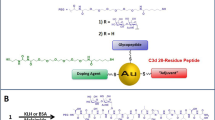Abstract
We attempted to improve antibody affinity by varying glycosylation on the light chain variable region. The human hybridoma line HB4C5 produces an antibody reactive to lung adenocarcinoma, which possess a N-glycosylated carbohydrate chain on the light chain hypervariable region. It has been shown that altering this carbohydrate structure can be accomplished by varying the level of N-acetylglucosamine in glucose free medium, a change in the carbohydrate chain could be induced which resulted in modifying antigen binding. By culturing the cells in media containing more than 20 mM N-acetylglucosamine, cells produced antibody with 10 fold improved affinity as compared with antibody produced in 20 mM glucose-containing medium. A newly induced light chain glycoform produced in the N-acetylglucosamine-containing medium was shown to be responsible for this antigen binding enhancement. Addition of glucose in the N-acetylglucosamine-containing media led to decreased antibody affinity and slightly inhibited production of a new light chain in a dose-dependent manner. Combination of 20 mM N-acetylglucosamine and 0.5 mM glucose gave a higher antibody production without the decrease of the antigen binding. These results indicate that optimization of N-glycosylation on the light chain, which leads to higher antigen binding, can be accomplished by adjusting a ratio of glucose and N-acetylglucosamine in the culture medium.
Similar content being viewed by others
References
Chothia C and Lesk AM (1987) Canonical structures for the hypervariable regions of immunoglobulins. J Mol Biol 196: 901–917.
Clamp JR, Bernier GM and Putnam FW (1964) Source of the apparent carbohydrate content of bence-jones proteins. Biochim Biophys Acta 86: 149–155.
Curling EMA, Hayter PM, Baines AJ, Bull AT, Gull K, Strange PG and Jenkins N (1990) Recombinant human interferon-γ. Biochem J 272: 333–337.
Goochee CF, Gramer MJ, Andersen DC, Bahr JB and Rasmussen JR (1991) The oligosaccharides of glycoproteins: bioprocess factors affecting oligosaccharide structure and their effect on glycoprotein properties. Biotechnol 9: 1347–1355.
Hashizume S, Kamei M, Mochizuki K, Sato S, Kuroda K, Kato M, Yasumoto K, Nakahashi H, Hirose H, Tai H, Okano H, Nomoto K and Murakami H (1991a) Serodiagnosis of cancer by using Candida cytochrome c recognized by human monoclonal antibody HB4C5. Hum Antibod Hybridomas 2: 142–147.
Hashizume S, Mochizuki K, Kamei M, Kuroda K, Kato M, Sato S, Yasumoto K, Nakahashi H, Tsuchimoto K, Muraoka M, Nomoto K and Murakami H (1991b) Serodiagnosis of cancer, using porcine carboxypeptidase A as an animal antigen recognized by human monoclonal antibody HB4C5. Hum Antibod Hybridomas 2: 150–155.
Kato, M, Mochizuki, Hashizume S, Tachibana H, Shirahata S and Murakami H (1993) Activity enhancement of a lung cancer-associated human monoclonal antibody HB4C5 by N-deglycosylation. Hum Antibod Hybridomas 4: 9–14.
Kagawa Y, Takasaki S, Utsumi J, Hosoi K, Shimizu H, Kochibe N and Kobata A (1988) Comparative study of the asparagine-linked sugar chains of natural human interferon-β1 and recombinant human interferon-β1 produced by three different mammalian cells. J Biol Chem 263: 17508–17515.
Kitano K, Shintani Y, Ichinmori Y, Tsukamoto K, Sasai S and Kida M (1986) Production of human monoclonal antibodies by heterohybridomas. Appl Microbiol Biotechnol 24: 282–286.
Koide N, Nose M and Muramatsu T (1977) Recognition of IgG by Fc receptor and complement: Effects of glycosidase digestion. Biochem Biophys Res Commun 75: 838–844.
Murakami H, Hashizume S, Ohashi H, Shinohara K, Yasumoto K, Nomoto K and Omura H (1985) Human-human hybridomas secreting antibodies specific to human lung carcinoma. In Vitro Cell Dev Biol 21: 593–596.
Murakami H, Masui H, Sato G, Sueoka N, Chow TP and Kano-Sueoka T (1982) Growth of hybridoma cells in serum-free medium: ethanolamine is an essential component. Proc Natl Acad Sci USA 79: 575–583.
Rearick JI, Chapman A and Kornfeld S (1981) Glucose starvation alters lipid linked oligosaccharide biosynthesis in chinese hamster ovary cells. J Biol Chem 256: 6255–6261.
Sox HC Jr and Hood L (1970) Attachment of carbohydrate to the variable region of myeloma immunoglobulin light chains. Proc Natl Acad Sci USA 66: 975–982.
Stark NJ and Heath EC (1979) Glucose-dependent glcosylation of secretory glycoprotein in mouse myelooma cells. Arch Biochem Biophys 192: 599–609.
Tachibana H, Shirahata S and Murakami H (1992) Generation of specificity-variant antibodies by alteration of carbohydrate in light chain of human monoclonal antibodies. Biochem Biophys Res Commun 189: 625–632.
Tachibana H, Seki K and Murakami H (1993) Identification of hybrid-type carbohydrate chains on the light chain of human monoclonal antibody specific to lung adenocarcinoma. Biochem Biophys Acta 1182: 257–263.
Tachibana H, Taniguchi K, Ushio Y, Teruya K, Osada K and Murakami H (1994) Changes of monosaccharides availability of human hybridoma lead to alteration of biological properties of human monoclonal antibody. Cytotechnology 16: 151–157.
Tachobana H, Kim J-Y, Murakami H (1995) Generation of affinity-variant antibodies via the alteration of glycosylation in light chain effected by defined culture conditions of human hybridomas. In: Animal Cell Technology: Developments towards the 21st. Century. Beuvery EC, Griffiths JB, Zeijlemaker WP (eds) pp 443–337. Kluwer Academic Publishers, Dordrecht, Netherlands.
Tachibana H, Kim J-Y, Taniguchi K, Ushio Y, Teruya K, Osada K, Inoue Y, Shirahata S and Murakami H (1996) Modified antigen-binding of human antibodies with glycosylation variations of the light chains produced in sugar-limited human hybridoma cultures. In Vitro Cell Dev Biol 32: 178–183.
Towbin H, Staehelin T and Gordon J (1979) Electrophoretic transfer of proteins from polyacrylamide gels to nitrocellulose sheets: Procedure and some applications. Proc Natl Acad Sci USA 76: 4350–4354.
Turco SJ (1980) Modification of oligosaccharide-lipid synthesis and protein glycosylation in glucose-deprived cells. Arch Biochem Biophys 205: 330–339.
Yano T, Yasumoto K, Nagashima A, Hashizume S, Murakami H and Nomoto K (1988) Immunohistological characterization of human monoclonal antibody against lung cancer. J Surg Oncol 39: 108–113.
Author information
Authors and Affiliations
Rights and permissions
About this article
Cite this article
Tachibana, H., Kim, Jy. & Shirahata, S. Building high affinity human antibodies by altering the glycosylation on the light chain variable region in N-acetylglucosamine-supplemented hybridoma cultures. Cytotechnology 23, 151–159 (1997). https://doi.org/10.1023/A:1007980032042
Issue Date:
DOI: https://doi.org/10.1023/A:1007980032042




